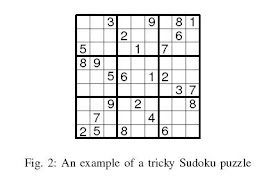
Angshul Majumdar just pointed out to me the following paper entitled: Linear Systems, Sparse Solutions, and Sudoku by Prabhu Babu, Kristiaan Pelckmans, Petre Stoica, and Jian Li. The abstract reads:
In this paper, we show that Sudoku puzzles can be formulated and solved as a sparse linear system of equations. We begin by showing that the Sudoku ruleset can be expressed as an underdetermined linear system: ${mmb{Ax}}={mmb b}$, where ${mmb A}$ is of size $mtimes n$ and $n>m$. We then prove that the Sudoku solution is the sparsest solution of ${mmb{Ax}}={mmb b}$, which can be obtained by $l_{0}$ norm minimization, i.e. $minlimits_{mmb x}Vert{mmb x}Vert_{0}$ s.t. ${mmb{Ax}}={mmb b}$. Instead of this minimization problem, inspired by the sparse representation literature, we solve the much simpler linear programming problem of minimizing the $l_{1}$ norm of ${mmb x}$, i.e. $minlimits_{mmb x}Vert{mmb x}Vert_{1}$ s.t. ${mmb{Ax}}={mmb b}$, and show numerically that this approach solves representative Sudoku puzzles.

I also found the following on arxiv: Compressed sensing performance bounds under Poisson noise by Maxim Raginsky, Zachary Harmany, Roummel Marcia, Rebecca Willett. The abstract reads:
This paper describes performance bounds for compressed sensing (CS) where the underlying sparse or compressible (sparsely approximable) signal is a vector of nonnegative intensities whose measurements are corrupted by Poisson noise. In this setting, standard CS techniques cannot be applied directly for several reasons. First, the usual signal-independent and/or bounded noise models do not apply to Poisson noise, which is non-additive and signal-dependent. Second, the CS matrices typically considered are not feasible in real optical systems because they do not adhere to important constraints, such as nonnegativity and photon flux preservation. Third, the typical $\ell_2$--$\ell_1$ minimization leads to overfitting in the high-intensity regions and oversmoothing in the low-intensity areas. In this paper, we describe how a feasible positivity- and flux-preserving sensing matrix can be constructed, and then analyze the performance of a CS reconstruction approach for Poisson data that minimizes an objective function consisting of a negative Poisson log likelihood term and a penalty term which measures signal sparsity. We show that, as the overall intensity of the underlying signal increases, an upper bound on the reconstruction error decays at an appropriate rate (depending on the compressibility of the signal), but that for a fixed signal intensity, the signal-dependent part of the error bound actually grows with the number of measurements or sensors. This surprising fact is both proved theoretically and justified based on physical intuition.
On his webpage, Roummel Marcia has the following announcement:
Opportunities: Positions for graduate and undergraduate students are available in the areas of optimization, linear algebra, and compressed sensing. These positions are in conjunction with the National Science Foundation grant, DMS-0811062: Second-order methods for large-scale optimization in compressed sensing. Send me an email if you are interested in any of these positions.
No comments:
Post a Comment